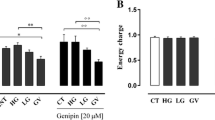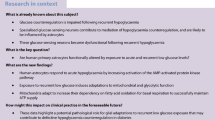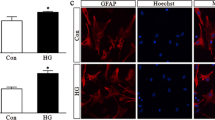Abstract
There is increasing evidence for glucose fluctuation playing a role in the damaging effects of diabetes on various organs, including the brain. We aimed to study the effects of glycaemic variation (GV) upon mitochondrial activity using an in vitro human neuronal model. The metabolic disturbance of GV in neuronal cells, was mimicked via exposure of neuroblastoma cells SH-SY5Y to constant glucose or fluctuating (i.e. 6 h cycles) for 24 and 48 h. Mitochondrial dehydrogenase activity was determined via MTT assay. Cell mitochondrial activity (MTT) was moderately decreased in constant high glucose, but markedly decreased following 24 and 48 h of cyclical glucose fluctuations. Glucose transport determined via 2-deoxy-D-[1-14C] glucose uptake was regulated in an exaggerated manner in response to glucose variance, accompanied by modest changes in GLUT 1 mRNA abundance. Osmotic components of these glucose effects were investigated in the presence of the osmotic-mimics mannitol and l-glucose. Both treatments showed that fluctuating osmolality did not result in a significant change in mitochondrial activity and had no effects on 14Cglucose uptake, suggesting that adverse effects on mitochondrial function were specifically related to metabolically active glucose fluctuations. Apoptosis gene expression showed that both intrinsic and extrinsic apoptotic pathways were modulated by glucose variance, with two major response clusters corresponding to (i) glucose stress-modulated genes, (ii) glucose mediated osmotic stress-modulated genes. Gene clustering analysis by STRING showed that most of the glucose stress-modulated genes were components of the intrinsic/mitochondrial apoptotic pathway including Bcl-2, Caspases and apoptosis executors. On the other hand the glucose mediated osmotic stress-modulated genes were mostly within the extrinsic apoptotic pathway, including TNF receptor and their ligands and adaptors/activators/initiators of apoptosis. Fluctuating glucose levels have a greater adverse effect on neuronal cell energy regulation mechanisms than either sustained high or low glucose levels.








Similar content being viewed by others
References
Agholme L, Lindstrom T, Kagedal K, Marcusson J, Hallbeck M (2010) An in vitro model for neuroscience: differentiation of SH-SY5Y cells into cells with morphological and biochemical characteristics of mature neurons. J Alzheimers Dis 20:1069–1082
Ahn Y-M, Kim SK, Kang J-S, Lee B-C (2012) Platycodon grandiflorum modifies adipokines and the glucose uptake in high-fat diet in mice and L6 muscle cells. J Pharm Pharmacol 64:697–704
Airoldi I, Di Carlo E, Cocco C, Taverniti G, D’Antuono T, Ognio E, Watanabe M, Ribatti D, Pistoia V (2007) Endogenous IL-12 triggers an antiangiogenic program in melanoma cells. Proc Natl Acad Sci USA 104:3996–4001
Baghurst PA, Rodbard D, Cameron FJ (2010) The minimum frequency of glucose measurements from which glycemic variation can be consistently assessed. J Diabetes Sci Technol 4:1382–1385
Biedler JL, Helson L, Spengler BA (1973) Morphology and growth, tumorigenicity, and cytogenetics of human neuroblastoma cells in continuous culture. Cancer Res 33:2643–2652
Bilan PJ, Mitsumoto Y, Ramlal T, Klip A (1992) Acute and long-term effects of insulin-like growth factor I on glucose transporters in muscle cells. Translocation and biosynthesis. FEBS Lett 298:285–290
Bratton SB, Lewis J, Butterworth M, Duckett CS, Cohen GM (2002) XIAP inhibition of caspase-3 preserves its association with the Apaf-1 apoptosome and prevents CD95- and Bax-induced apoptosis. Cell Death Differ 9:881–892
Budihardjo I, Oliver H, Lutter M, Luo X, Wang X (1999) Biochemical pathways of caspsase activation during apoptosis. Annu Rev Cell Dev Biol 15:269–290
Cameron FJ, Baghurst PA, Rodbard D (2010) Assessing glycemic variation: why, when and how? Pediatr Endocrinol Rev 7(Suppl 3):432–444
Cameron FJ, Northam EA, Ambler GR, Daneman D (2007) Routine psychological screening in youth with type 1 diabetes and their parents: a notion whose time has come? Diabetes Care 30:2716–2724
Cardoso S, Santos MS, Seica R, Moreira PI (2010) Cortical and hippocampal mitochondria bioenergetics and oxidative status during hyperglycemia and/or insulin-induced hypoglycemia. Biochim Biophys Acta 1802:942–951
Ceriello A, Ihnat MA (2010) ‘Glycaemic variability’: a new therapeutic challenge in diabetes and the critical care setting. Diabet Med 27:862–867
Chen N, Ye XC, Chu K, Navone NM, Sage EH, Yu-Lee LY, Logothetis CJ, Lin SH (2007) A secreted isoform of ErbB3 promotes osteonectin expression in bone and enhances the invasiveness of prostate cancer cells. Cancer Res 67:6544–6548
Christensen J, Steain M, Slobedman B, Abendroth A (2011) Differentiated neuroblastoma cells provide a highly efficient model for studies of productive varicella-zoster virus infection of neuronal cells. J Virol, JVI.00515–JVI.00511
Cregan SP, Fortin A, MacLaurin JG et al (2002) Apoptosis-inducing factor is involved in the regulation of caspase-independent neuronal cell death. J Cell Biol 158:507–517. doi:10.1083/jcb.200202130
Davis EA, Soong SA, Byrne GC, Jones TW (1996) Acute hyperglycaemia impairs cognitive function in children with IDDM. J Pediatr Endocrinol Metab 9:455–461
Fladeby C, Bjonness B, Serck-Hanssen G (1996) GLUT1-mediated glucose transport and its regulation by IGF-I in cultured bovine chromaffin cells. J Cell Physiol 169:242–247
Fladeby C, Skar R, Serck-Hanssen G (2003) Distinct regulation of glucose transport and GLUT1/GLUT3 transporters by glucose deprivation and IGF-I in chromaffin cells. Biochim Biophys Acta 1593:201–208
Giannini S, Benvenuti S, Luciani P et al (2008) Intermittent high glucose concentrations reduce neuronal precursor survival by altering the IGF system: the involvement of the neuroprotective factor DHCR24 (Seladin-1). J Endocrinol 198:523–532
Gonder-Frederick LA, Zrebiec JF, Bauchowitz AU, Ritterband LM, Magee JC, Cox DJ, Clarke WL (2009) Cognitive function is disrupted by both hypo- and hyperglycemia in school-aged children with type 1 diabetes: a field study. Diabetes Care 32:1001–1006
Green DR (2000) Apoptotic pathways: paper wraps stone blunts scissors. Cell 102:1–4
Hansen MB, Nielsen SE, Berg K (1989) Re-examination and further development of a precise and rapid dye method for measuring cell growth/cell kill. J Immunol Methods 119:203–210
Higgins S, Wong SHX, Richner M, Rowe CL, Newgreen DF, Werther GA, Russo VC (2009) Fibroblast growth factor 2 reactivates G1 checkpoint in SK-N-MC cells via regulation of p21, inhibitor of differentiation genes (Id1-3), and epithelium-mesenchyme transition-like events. Endocrinology 150:4044–4055. doi:10.1210/en.2008-1797
Ikeda R, Iwashita KI, Sumizawa T et al (2008) Hyperosmotic stress up-regulates the expression of major vault protein in SW620 human colon cancer cells. Exp Cell Res 314:3017–3026
Inoue JI, Ishida T, Tsukamoto N, Kobayashi N, Naito A, Azuma S, Yamamoto T (2000) Tumor necrosis factor receptor-associated factor (TRAF) family: adapter proteins that mediate cytokine signaling. Exp Cell Res 254:14–24
Kobayashi K, Xin Y, Ymer SI, Werther GA, Russo VC (2007) Subtractive hybridisation screen identifies genes regulated by glucose deprivation in human neuroblastoma cells. Brain Res 1170:129–139
Kong A, Donath S, Harper CA, Werther GA, Cameron FJ (2005) Rates of diabetes mellitus-related complications in a contemporary adolescent cohort. J Pediatr Endocrinol Metab 18:247–255
Lee MS, Choi S-E, Ha ES, et al (2012) Fibroblast growth factor-21 protects human skeletal muscle myotubes from palmitate-induced insulin resistance by inhibiting stress kinase and NF-κB. Metabolism (in press)
Livak KJ, Schmittgen TD (2001) Analysis of relative gene expression data using real-time quantitative PCR and the 2−ΔΔCT method. Methods 25:402–408
Lopes FM, Schröder R, da Frota ML Jr et al (2010) Comparison between proliferative and neuron-like SH-SY5Y cells as an in vitro model for Parkinson disease studies. Brain Res 1337:85–94
Maher EA, Marin-Valencia I, Bachoo RM, et al. (2012) Metabolism of [U-13C]glucose in human brain tumors in vivo. NMR in Biomed
Mohsin F, Craig ME, Cusumano J, Chan AK, Hing S, Lee JW, Silink M, Howard NJ, Donaghue KC (2005) Discordant trends in microvascular complications in adolescents with type 1 diabetes from 1990 to 2002. Diabetes Care 28:1974–1980
Nagata S (1999) Fas ligand-induced apoptosis. Annu Rev Genet 33:29–55
Nalysnyk L, Hernandez-Medina M, Krishnarajah G (2010) Glycaemic variability and complications in patients with diabetes mellitus: evidence from a systematic review of the literature. Diabetes Obes Metab 12:288–298
Northam EA, Rankins D, Cameron FJ (2006) Therapy insight: the impact of type 1 diabetes on brain development and function. Nat Clin Pract Neurol 2:78–86
Orlinick JR, Chao MV (1998) TNF-related ligands and their receptors. Cell Signal 10:543–551
Ose N, Sawabata N, Minami M, Inoue M, Shintani Y, Kadota Y, Okumura M (2012) Lymph node metastasis diagnosis using positron emission tomography with 2-[18F] fluoro-2-deoxy-d-glucose as a tracer and computed tomography in surgical cases of non-small cell lung cancer. Eur J Cardio Thoracic Surg 1–4. doi:10.1093/ejcts/ezr287
Otto NM, Schindler R, Lun A, Boenisch O, Frei U, Oppert M (2008) Hyperosmotic stress enhances cytokine production and decreases phagocytosis in vitro. Crit Care 12:R107
Ozturk G, Erdogan E, Ozturk M, Cengiz N, Him A (2008) Differential analysis of effect of high glucose level in the development of neuropathy in a tissue culture model of diabetes mellitus: role of hyperosmolality. Exp Clin Endocrinol Diabetes 116:582–591
Piconi L, Quagliaro L, Assaloni R, Da Ros R, Maier A, Zuodar G, Ceriello A (2006) Constant and intermittent high glucose enhances endothelial cell apoptosis through mitochondrial superoxide overproduction. Diabetes Metab Res Rev 22:198–203
Poomthavorn P, Wong SHX, Higgins S, Werther GA, Russo VC (2009) Activation of a prometastatic gene expression program in hypoxic neuroblastoma cells. Endocr Relat Cancer 16:991–1004. doi:10.1677/ERC-08-0340
Purcell SH, Chi MM, Moley KH (2012) Insulin-stimulated glucose uptake occurs in specialized cells within the cumulus oocyte complex. Endocrinology 153(5):2444–2454
Quagliaro L, Piconi L, Assaloni R, Martinelli L, Motz E, Ceriello A (2003) Intermittent high glucose enhances apoptosis related to oxidative stress in human umbilical vein endothelial cells: the role of protein kinase C and NAD(P)H-oxidase activation. Diabetes 52:2795–2804
Racz B, Reglodi D, Fodor B, Gasz B, Lubics A, Gallyas JF, Roth E, Borsiczky B (2007) Hyperosmotic stress-induced apoptotic signaling pathways in chondrocytes. Bone 40:1536–1543
Rangel-Moreno J, Hartson L, Navarro C, Gaxiola M, Selman M, Randall TD (2006) Inducible bronchus-associated lymphoid tissue (iBALT) in patients with pulmonary complications of rheumatoid arthritis. J Clin Invest 116:3183–3194
Risso A, Mercuri F, Quagliaro L, Damante G, Ceriello A (2001) Intermittent high glucose enhances apoptosis in human umbilical vein endothelial cells in culture. Am J Physiol Endocrinol Metab 281:E924–E930
Rivolta I, Panariti A, Lettiero B, Sesana S, Gasco P, Gasco MR, Masserini M, Miserocchi G (2011) Cellular uptake of coumarin-6 as a model drug loaded in solid lipid nanoparticles. J Physiol Pharmacol 62:45–53
Russo VC, Kobayashi K, Najdovska S, Baker NL, Werther GA (2004) Neuronal protection from glucose deprivation via modulation of glucose transport and inhibition of apoptosis: a role for the insulin-like growth factor system. Brain Res 1009:40–53
Ryan CM (2006) Why is cognitive dysfunction associated with the development of diabetes early in life? The diathesis hypothesis. Pediatr Diabetes 7:289–297
Ryan CM, Atchison J, Puczynski S, Puczynski M, Arslanian S, Becker D (1990) Mild hypoglycemia associated with deterioration of mental efficiency in children with insulin-dependent diabetes mellitus. J Pediatr 117:32–38
Ryan CM, Becker DJ (1999) Hypoglycemia in children with type 1 diabetes mellitus. Risk factors, cognitive function, and management. Endocrinol Metab Clin North Am 28:883–900
Salvesen GS, Dixit VM (1999) Caspase activation: the induced-proximity model. Proc Natl Acad Sci USA 96:10964–10967
Schisano B, Tripathi G, McGee K, McTernan PG, Ceriello A (2011) Glucose oscillations, more than constant high glucose, induce p53 activation and a metabolic memory in human endothelial cells. Diabetologia 54:1219–1226
Schulze-Osthoff K, Ferrari D, Los M, Wesselborg S, Peter ME (1998) Apoptosis signaling by death receptors. Eur J Biochem 254:439–459
Siegelaar SE, Holleman F, Hoekstra JB, DeVries JH (2010) Glucose variability; does it matter? Endocr Rev 31:171–182
Szklarczyk D, Franceschini A, Kuhn M et al (2011) The STRING database in 2011: functional interaction networks of proteins, globally integrated and scored. Nucleic Acids Res 39:D561–D568
Tomlinson DR, Gardiner NJ (2008) Glucose neurotoxicity. Nat Rev Neurosci 9:36–45
Vincent AM, Russell JW, Low P, Feldman EL (2004) Oxidative stress in the pathogenesis of diabetic neuropathy. Endocr Rev 25:612–628
Yonezawa T, Kurata R, Kimura M, Inoko H (2011) Which CIDE are you on? Apoptosis and energy metabolism. Mol BioSyst 7:91–100
Yu Y, Li W, Wojciechowski B, Jenkins AJ, Lyons TJ (2007) Effects of D- and l-glucose and mannitol on retinal capillary cells: inhibition by nanomolar aminoguanidine. Am J Pharmacol Toxicol 2:148–158
Acknowledgments
We wish to thanks Miss Romanie Dekker and Miss Michelle de Mol (VU University of Amsterdam The Netherland) for their technical assistance in the preliminary set up of these studies.
Author information
Authors and Affiliations
Corresponding author
Rights and permissions
About this article
Cite this article
Russo, V.C., Higgins, S., Werther, G.A. et al. Effects of Fluctuating Glucose Levels on Neuronal Cells In Vitro. Neurochem Res 37, 1768–1782 (2012). https://doi.org/10.1007/s11064-012-0789-y
Received:
Revised:
Accepted:
Published:
Issue Date:
DOI: https://doi.org/10.1007/s11064-012-0789-y




